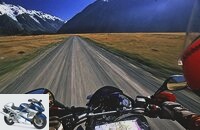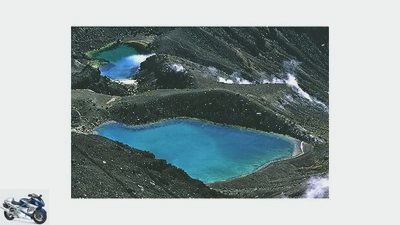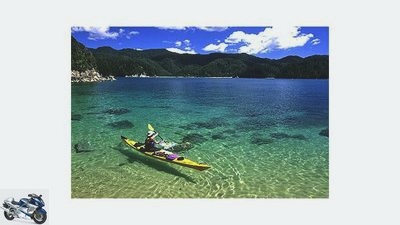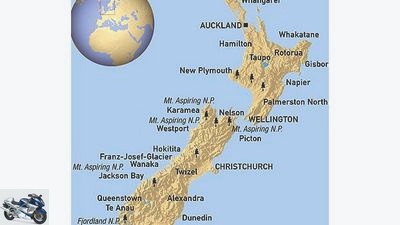Table of contents
 Jo Deleker
Jo Deleker
to travel
New Zealand
New Zealand Kiwi Country
There are three types of kiwi fruit: the fruit, the bird, and the New Zealander. The latter self-confidently refer to their extremely diverse islands as ?? Godzone ?? ?? promised land.
Joachim Deleker
12/23/2005
The verdict of the technical examiner hits me like a blow: no badge for the brand new XT I brought with me.
Without the stamp, however, I cannot register the motorcycle and therefore cannot drive it. The problem: the headlight, which is not designed for left-hand traffic and persistently defies all attempts at adjustment. My advice that continental Europeans when they visit England put black, wedge-shaped adhesive tape on the headlights is new to the examiner. He thinks about it for a moment, disappears into his office and comes back with a first aid kit, from which he pulls a plaster with a grin. He meticulously fixes the XT lamp, finally sticks the WoF stamp on the tank, the approval sticker on the aluminum box and wishes me a lot of fun in Aotearoa, the land of the long white cloud.
When I leave Auckland, the prospect of three months of freedom keeps helicopters in my stomach. As if in a frenzy, I perceive the seemingly endless suburbs with their beautiful wooden houses, later the spacious farms, nestled between gentle green hills. The warm, humid subtropical air smells of summer, sea and flowers. For hours I follow Highway 12 northwards, always towards the sun. Until the road is suddenly swallowed up by the impenetrable jungle of the Waipoua Forest. Exotic fern trees and gigantic Kauri trees, 1,500 years old and five meters thick, testify to what the North Island looked like before the arrival of the people. New Zealand in its original condition.
Buy complete article

New Zealand Kiwi country
12 pages) as PDF
€ 2.00

Jo Deleker
Volcanic rush of colors: The earth’s formation is not over yet around the Emerald Lakes in Tongariro National Park.
As suddenly as the jungle took me in, it spits me out again. In Ahipara, the XT rolls onto a picture-perfect beach, the infamous Ninety Mile Beach. Driving on the beach is permitted and the opportunity is favorable. I still have four hours until the tide is back and the narrow strip of sand is under water. Let’s go. The finest yellow sand stretches to the horizon, on the port side the endless expanse of the Tasman Sea glistens, and on the starboard side dunes tower up, from which the stiff east wind drives thin sand flags over the beach. At first, soft holes lurk in the ground, the XT seem to want to suck up. Maximum adrenaline production, because getting stuck wouldn’t be a good idea. I quickly get a feel for the ground, learn to read the soft sections and accelerate in good time. The fear of burrowing vanishes in the happiness of surfing. An unearthly feeling. When the tide comes in, I have long been standing at Cape Reinga, the North Cape of New Zealand. The Pacific Ocean and the Tasman Sea meet 160 meters below the white lighthouse, creating wild water eddies and long waves that drain into the outrageously beautiful Te Werahi Bay. An older kiwi joins me and wants to know why my motorcycle has such a large license plate. “Oh, from Germany!” His look reveals appreciation and he begins to talk about his relatives in England. I barely understand half of it. Kiwi English takes getting used to. Before he shuffles over to his motorhome, he taps me on the shoulder with a grin: “Do you know what we kiwis are most afraid of?” I don’t know. “That we’re falling off the map and the rest of the world doesn’t even notice.”
New Zealand – paradise?
New Zealand’s tourism managers never tire of promoting the most beautiful end of the world as a unique natural paradise. In fact, there is hardly any other country in which nature conservation has such a high priority. 30 percent of the country’s area of 270,000 square kilometers is under strict protection. Most of the rest, however, is used for forestry and agriculture and has 130 million inhabitants: four million people, nine million cows, 47 million sheep and 70 million possums, which have been officially declared a plague because they are devouring entire forests. Those who only expect untouched nature are often disappointed, as they mostly move through a cultural landscape of farmland with fenced-in meadows and man-made forests.
Before the Maori came to New Zealand about 700 years ago, the islands were actually a paradise with numerous endemic species, such as the giant bird moa, the world’s largest parrot Kekapo or the famous kiwi. None of these birds could fly, but due to the lack of enemies, they didn’t need to. They were only brought in by the people, especially the Europeans. Rats, dogs and cats killed the flightless birds. Only the kiwi survived, but is still considered threatened. There are frighteningly few birds in New Zealand today. Experts estimate that it is almost 95 percent less than before the arrival of whites in the late 18th century.
The forest fared little better. By the middle of the 20th century, almost 90 percent had been cleared or burned down. Only then did the government gradually put the remaining areas under nature protection and begin afforestation. Today, mostly imported pines thrive, which after a few decades are “harvested” by clear-cutting and cause ugly scars in nature. The traveler can still find the untouched wonderland of the jungle. All he has to do is drive to one of the protected areas such as the Fiordland, the Oparara Basin or the Te Urewera National Park.
New Zealand (2)

Jo Deleker
England in the morning, Chile at noon, Canada in the evening.
It is 2000 kilometers from Cape Reinga to the southern tip at Invercargill. The shortest route. But I’m not interested in that, after all, I have time. So I set my sights on the east coast, come to Waitangi, where the state-founding treaty between Maori and English was negotiated in 1840, cross over the Coromandel Peninsula with its fairytale fern tree forests, drive along the lonely coastal road to the wild Eastern Cape and finally land in Rotorua, that stinks from a distance to the sky. Gray mud bubbles around every corner, sulphurous steam hisses from the torn ground and geysers chase boiling water into the sky. The earth is still alive here. Rotorua is not only the country’s volcanic hotspot, but also the cultural center of the Maori. Nowhere else is the history and present of the indigenous people so close. No wonder I keep stumbling over monstrous words from the Maori language. The large thermal area is called Whakarewarewa, the much nicer Wai-o-tapu and the mountain next door is called Ngongotaha. The volcanic zone peaks in the spectacular Tongariro National Park. The magic of these mighty volcanoes does not, however, reveal itself by driving past. I pack my rucksack and take the famous Tongariro Crossing under my hiking boots before sunrise, climb up to the Red Crater, the highest point of the 17-kilometer trail at 1,886 meters. What a grandiose scenery: right in front of me the huge brown volcanic cone of the Ngauruhoe and the red crater, which looks as if glowing lava could pour out of its chimney at any moment, and a few meters further the Emerald Lakes glow in an unreally transparent turquoise.
130 kilometers away, the Taranaki volcano greets you over the valleys lying in the mist. A Maori I meet at Red Crater tells me why the Taranaki is so far away: “A long time ago, the Taranaki was also part of the Tongariro volcanoes. But then the Tongariro caught him red-handed with the beautiful Pihanga, who stupidly was Tongariro’s lover. The Taranaki was afraid of the anger of the mighty Tongariro, consequently left the field as quickly as possible and only settled down on the coast at a safe distance. ”The geologists certainly have a different story about the origins of the Taranaki, but whether it is so beautiful?

Jo Deleker
Better than the South Seas: float through the Abel Tasman National Park in a sleek sea kayak.
The next few days when I drive the XT to Wellington are not worth mentioning. Boring pastureland along the way too crowded highway, uniform places, nothing worth a break. That changes suddenly across the Cook Strait, which separates the North and South Islands. As soon as I left the ferry in Picton, a wealth of impressions patter through my visor. The countless curves of Queen Charlotte Drive, which winds through lush green jungle and surprises with a new view around every bend. Or the slopes to Titirangi and French Pass in the lonely Marlborough Sounds. Almost traffic-free panoramic roads of the first class, which offer intoxicating views over the labyrinth of fjords and islands as well as unlimited driving pleasure. In between, tiny tent sites in beautiful bays. Man, forget the highly acclaimed Bay of Islands and the Coromandel Peninsula, the Marlborough Sounds are light years better! Reluctantly, I leave this paradise and head for Christchurch to pick up my wife Birgit from the airport, who will accompany me in the saddle of a rented BMW F 650 Dakar for the next five weeks. We set our sights on the Abel Tasman National Park and swap the motorbikes for sleek sea kayaks, because that’s the only way to really explore this corner of New Zealand. Countless bays – one more beautiful than the other – with golden-yellow sandy beaches and dense, green jungle. The yellow kayaks seem to float over the crystal clear water. In the evening our tent is on one of these fairytale beaches, we crouch by the water, marvel at the starry sky in the south and listen to the silence that is only disturbed by the moaning of an opossum. There are moments when an infinite satisfaction floods the body, when everything fits. The euphoria lasted for three days during the entire kayak tour. The good weather stays true to us. Not a matter of course for the famous west coast, known by the Kiwis as the “Wet Coast”. 600 kilometers from Karamea to Jackson Bay, hardly a handful of places in between. Highway 6 is the only connection. South of Charleston it does a lot, winding its way from canyon to canyon like a roller coaster. All that’s missing is a loop. The Tasmanian Sea rushes on the right, and impenetrable rainforest grows on the left. Here and there a small place with meticulously cared for wooden houses, a café, a bar and a general store. The locals drive practical pick-ups and say hello as they drive by. An extremely relaxed atmosphere. Until we get to Franz Josef, the tourist mecca of the west coast. Everyone wants to see Mount Cook and feel its glaciers. And book one of the helicopters that roar incessantly up to the ice fields and land there for a few minutes. Most visitors come from Australia and Southeast Asia and see a real glacier for the first time. For them, these flights are the greatest of all. Those who know the Alps, on the other hand, can only smile at these tiny ice fields.
New Zealand (3)

Jo Deleker
New Zealand attracts with a variety of landscapes that few areas can offer in such a small space. Traveling is very easy, the infrastructure is perfect, the people are easy-going and remarkably friendly.
A storm depression approaching from the west drives Birgit and me to the other side of the mountains, the Southern Alps, to Queenstown, the self-proclaimed adventure metropolis of the southern hemisphere. The adrenaline kicks you can book here are unmanageable: bungee jumping from the bridge, with a parachute or from the cable car, heli-hiking, heli-biking or heli-I-don’t-know-what. Queenstown is booming. The steamer “SS Earnslaw”, which has been plowing through the waves of the huge Lake Wakatipu for 93 years, seems downright anachronistic. The pot even takes motorbikes. We will not miss this journey through time. Especially since an exciting slope begins on the other side of the lake, which leads a good 85 kilometers over a barren and wide plateau that is reminiscent of images of South American Patagonia. Immediately afterwards the rainforests of the fjord country – the contrast couldn’t be greater. Only one road penetrates into the spectacular wilderness of the fjords, finally ending at the world-famous Milford Sound. The entire southwestern tip of New Zealand is protected as the Te Wahipounamu National Park. An area larger than Hessen that only allows visitors a tiny glimpse. Unless it rains – which rarely happens, however. We too have to wait for better times, experience rain with an intensity never seen before and luckily find shelter in a rustic hostel. “Hey guys”, Carry, who lives in Milford, doesn’t overlook our astonishment at the masses of water falling from the sky, “that’s nothing at all. A few years ago it came down 1.80 meters in three days. ”In Mainz this amount falls in three years.
As soon as the rain stops, the only predators on the west coast venture out of their hiding places – sand flies in unimagined numbers. These small, piercing objects in flight are capable of driving even the most serene mind crazy. The Maori know why: “The Fiordland is the most beautiful place in the world. People should be amazed. But so that they don’t stay, God sent the sand flies. “Well, then it goes on. Over the “Southern Scenic Highway” many lonely kilometers through vast farmland to Te Waewae Bay on the south coast. Powerful waves roll on the deserted beach, which is actually already opposite the Antarctic. The landscape to the east becomes uneventful. Meadows, countless sheep and never-ending fences accompany us. Probably no other country has as many fences as New Zealand. The real highlights of the southeast are the animals. Fat Hooker sea lions, rare yellow-eyed penguins and the majestic king albatrosses with their wingspan of more than three meters. But we can’t really enjoy all of this because lead-gray sea fog has been creating a depressing mood for days. Until one morning we decide to flee immediately. The longing for sun and warmth only allows one plan – drive until we get light again.

new zealand_karte.jpg
Regardless of whether you are flying west over the USA or east over Asia, New Zealand is 20,000 kilometers away from Germany. This corresponds to a pure flight time of around 24 hours.
Just three hours later: Alexandra, Central Otago, cloudless and 25 degrees. The first cafe is stormed, there are freshly baked cakes and the second best cappuccino in the world. Only the Italians can do it better. Alexandra is the gateway to the Southern Lakes, seven large lakes that stretch from the Otagos grass steppe to the Southern Alps. Each of these lakes has a completely different character. One is steel gray, the next ice blue and another milky green. We already know the southern lakes, so we follow Highway 8 to the Lindis Pass. It gets really lonely there. Yellow tussock grass as far as the eye can see, barren, black-brown mountains not a single house. And suddenly Lake Pukaki, a 35 kilometer long turquoise-green glacial lake. At its northern end rise like a gigantic wall the Southern Alps with their celebrities Mount Tasman and Mount Cook. How unimpressive these mountains looked from the other side, from Franz Josef. Only here do the majestic giants show their true colors. Birgit and I exhaust the last few days until departure, explore the exciting gravel paths along the lakes Pukaki and Tekapo or just sit in front of the tent and admire the glaciated mountains. The Southern Lake region is without a doubt one of the highlights of the trip. Just now a tropical rainforest and now Canada, Argentina and Norway all at once – tiny New Zealand combines completely different landscapes that can otherwise only be found on several continents. And that is exactly what makes the country so appealing, namely the feeling of having traveled almost the whole world.
Info
getting there
Regardless of whether you are flying west over the USA or east over Asia, New Zealand is 20,000 kilometers away from Germany. This corresponds to a pure flight time of around 24 hours. The higher free baggage allowance speaks in favor of the flight via the USA, and the greater offer for the Asia route. Flight tickets via Korea, Singapore or Bangkok to Auckland or Christchurch cost in the high season from around 1100 euros. The America variant is a little more expensive. One-day or multi-day stopovers in Asia, Australia, the USA or the South Pacific are possible.
Travel time
The main season is between Christmas and the beginning of March – and then it can get really crowded on the two islands. The months of April and May are much quieter, but not so warm and dry either. In the preseason in November and December there is hardly anything going on either, but it rains more often during this time. Summer temperatures on the North Island fluctuate between 20 and 30 degrees during the day, while it is five degrees cooler on the South Island. The warmest places in New Zealand in summer and coldest in winter are in Central Otago, which, under the protection of the Southern Alps, offers an almost continental climate. The best weather report is available on the Internet at www.metservice.co.nz.
Documents
The passport must be valid for at least three months upon entry. A residence permit is issued for 90 days and can be extended on site. A Carnet de Passages is required for your own motorcycle, which is available from ADAC. National driver’s license and vehicle registration are accepted. There is no compulsory insurance, but so-called “third party insurance” is recommended, which costs around 95 euros for three months and can be taken out on site.
motorcycles
There are several ways to realize your dream New Zealand on a motorcycle. Those who spend longer with the Kiwis can take their own motorcycle with them or buy a bike on site. For normal vacationers, rental motorcycles are an option. There is also a wide range of guided tours. You can find detailed information on all questions about motorcycles in New Zealand on the following pages.
Stay
Free camping is allowed outside of nature reserves and private property, but only rarely possible – the whole country is almost completely fenced. The numerous campsites are generously equipped with common rooms, kitchens or even TV rooms. A tent and one person cost six to ten euros per night. In addition to the private campgrounds, the Department of Conservation (DOC) maintains almost 200 mostly simple campsites in often very beautiful locations (information at www.doc.govt.nz). Those who prefer to sleep in bed will find a number of »backpackers«, simple hostels that are hardly more expensive than good campsites. There are also numerous »Bed & Breakfast «- accommodations, motels and hotels in all price ranges.
activities
The range of outdoor activities seems inexhaustible in New Zealand, and Queenstown has established itself as the epicenter for a fast adrenaline rush. Those who have nothing to do with bungee jumping, jet boating or abseiling and prefer to exercise in the grandiose nature are also spoiled for choice. Thousands of kilometers of hiking trails criss-cross the country’s national parks. Some are so popular that access had to be regulated. The most famous trail, the Milford Track, is usually fully booked before Christmas until the end of the season on April 30th. Up to 500 people cavort on the Tongariro Crossing a day in January, but barely a dozen in May. In addition, the rugged coast with its sheltered bays and fjords invites you to paddle. The most beautiful kayak areas are the Abel Tasman National Park, the Marlborough Sounds and the Milford Sound (here only guided tours).
information
Almost every place has its own “Visitor Center”, which helps with extensive material and often has valuable tips ready that are not in the travel guide. There is also the DOC information center, which provides information on flora, fauna, geology and the weather. The Internet also offers a huge amount of information. Recommended sites: www.nz.com, www.newzealand.com, www.travelplaner.co.nz, www.purenz.com.
literature
As an almost omniscient travel guide, »New Zealand« from the Lonely Planet publishing house is recommended. The English-language book costs 22.90 euros. The Stefan-Loose-Verlag also has a good guide for 24.95 euros. “New Zealand, the most beautiful national parks” by Reise Know-How helps to plan tours in the parks for 19.90 euros. Two exceptionally good illustrated books are ideal for getting in the mood for the trip: “Fascination New Zealand”, Tecklenborg-Verlag, for 45 euros and “Nature New Zealand” from Styria-Verlag for 49.90 euros. The New Zealand map on a scale of 1: 1,000,000 from Reise Know-How has proven to be a useful overview map (8.90 euros). Significantly more detailed: the map atlas “Kiwi Pathfinder-New Zealand” from the publishing house Kiwimaps, in 1: 500000. The Atlas is only available in New Zealand, fits in the tank bag and shows almost all routes. More pictures of this New Zealand trip can be found on the author’s website: www.jodeleker.de.
Related articles
-
Motorcycle racing in New Zealand Horst Saiger
Saiger / Doug Cornes 20th pictures Saiger / Doug Cornes 1/20 Horst Saiger accepted the official invitation to the Suzuki series, … Saiger / Doug Cornes…
-
Motorbike rentals in Australia and New Zealand
to travel Motorbike rentals in Australia and New Zealand Motorbike rentals in Australia and New Zealand Biking down under Where better to escape the…
-
MOTORCYCLE On the Road: Tunisia
Huh to travel MOTORCYCLE On the Road: Tunisia On the way: Tunisia Wind, sand and stars Tunisia attracts with beach and sun. Those who only go on vacation…
-
Daams to travel Montenegro Montenegro Phoenix from the ashes The southernmost fjord, the deepest canyon and one of the last primeval forests in Europe ??…
-
to travel Bulgaria Bulgaria Southeast course Bulgaria – cheap travel destination? A transit country in south-east Europe on the way to Turkey? True, but…
-
to travel Baltic states Baltic states Different than expected Beaches like on the Mediterranean, cappuccino like in Italy and magnificent buildings that…
-
to travel South America ?? Antarctic South America ?? Antarctic 42 degrees of latitude On two enduros through the Andes ?? from the Chilean Atacama…
-
Bikes for 999 euros and the consequences, part 7
Artist counselor Used purchase Bikes for 999 euros and the consequences, part 7 Bikes for 999 euros and the consequences, part 7 The time was good Have…
-
Deleker 13th pictures Joachim Deleker 1/13 There are many small towns to explore. Joachim Deleker 2/13 A beautiful panorama at sunset. Joachim Deleker…
-
to travel Western Australia Western Australia New home Rolf Henniges’ childhood memories came back to life during his trip to Australia. So there is…